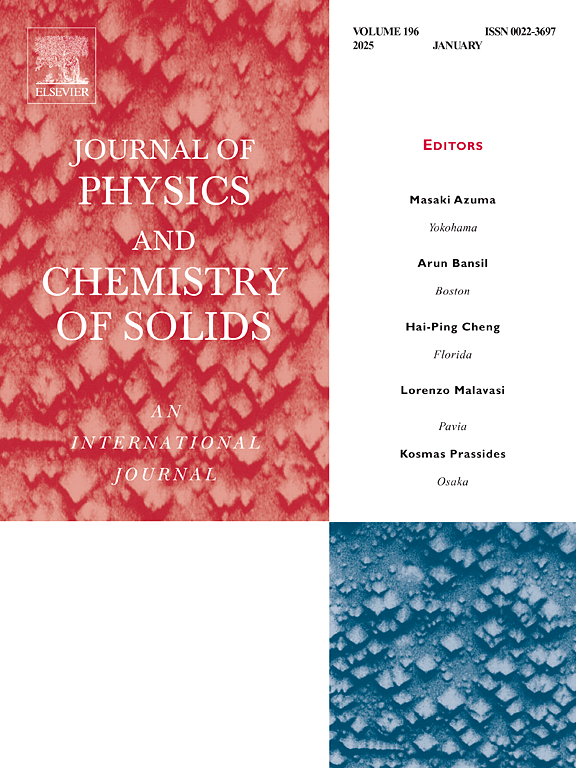From UV to IR: Unveiling the photocatalytic and optoelectronic promise of Cs2ReX (X= Cl, Br, I) compounds
IF 4.9
3区 材料科学
Q2 CHEMISTRY, MULTIDISCIPLINARY
引用次数: 0
Abstract
In this study, the structural, electronic, optical, and magnetic properties of vacancy-ordered double perovskites Cs2ReX6 (X = Cl, Br, I) are investigated using density functional theory (DFT). GGA + mBJ calculations yield band gaps of 2.68 eV (Cl), 2.19 eV (Br), and 1.40 eV (I). The valence band maximum (VBM) potentials decrease from +2.54 V to +1.88 V and +1.11 V versus the normal hydrogen electrode (NHE), while the conduction band minimum (CBM) values are −0.14 V, −0.31 V, and −0.29 V, respectively. These trends are influenced by increasing halogen ionic radius and decreasing electronegativity. Mechanical stability is confirmed through elastic constants, and all compounds show ductile behavior. Cs2ReI6 exhibits enhanced infrared absorption and the highest dielectric constant (ε1(∞) = 7.62), indicating strong optical response in the IR region. Magnetic calculations reveal a ferromagnetic ground state for all compounds, with total magnetic moments close to 3 μB, mainly contributed by Re 5d electrons. The combination of favorable band edge positions, stable ferromagnetism, and strong light absorption suggests that Cs2ReX6 materials are promising candidates for photocatalysis, optoelectronics, and spintronic devices.
从紫外到红外:揭示Cs2ReX (X= Cl, Br, I)化合物的光催化和光电子前景
本文利用密度泛函理论(DFT)研究了空位有序双钙钛矿Cs2ReX6 (X = Cl, Br, I)的结构、电子、光学和磁性。GGA + mBJ计算得到的带隙分别为2.68 eV (Cl)、2.19 eV (Br)和1.40 eV (I)。与普通氢电极(NHE)相比,价带最大值(VBM)从+2.54 V降至+1.88 V和+1.11 V,而导带最小值(CBM)分别为- 0.14 V、- 0.31 V和- 0.29 V。这些趋势受卤素离子半径增大和电负性减小的影响。力学稳定性由弹性常数确定,所有化合物均表现出延性。Cs2ReI6表现出增强的红外吸收和最高的介电常数(ε1(∞)= 7.62),表明在红外区域有较强的光学响应。磁性计算表明,所有化合物的基态均为铁磁性,总磁矩接近3 μB,主要由Re 5d电子贡献。良好的能带边缘位置、稳定的铁磁性和强的光吸收表明,Cs2ReX6材料是光催化、光电子和自旋电子器件的有希望的候选者。
本文章由计算机程序翻译,如有差异,请以英文原文为准。
求助全文
约1分钟内获得全文
求助全文
来源期刊
CiteScore
7.80
自引率
2.50%
发文量
605
审稿时长
40 days
期刊介绍:
The Journal of Physics and Chemistry of Solids is a well-established international medium for publication of archival research in condensed matter and materials sciences. Areas of interest broadly include experimental and theoretical research on electronic, magnetic, spectroscopic and structural properties as well as the statistical mechanics and thermodynamics of materials. The focus is on gaining physical and chemical insight into the properties and potential applications of condensed matter systems.
Within the broad scope of the journal, beyond regular contributions, the editors have identified submissions in the following areas of physics and chemistry of solids to be of special current interest to the journal:
Low-dimensional systems
Exotic states of quantum electron matter including topological phases
Energy conversion and storage
Interfaces, nanoparticles and catalysts.

 求助内容:
求助内容: 应助结果提醒方式:
应助结果提醒方式:


